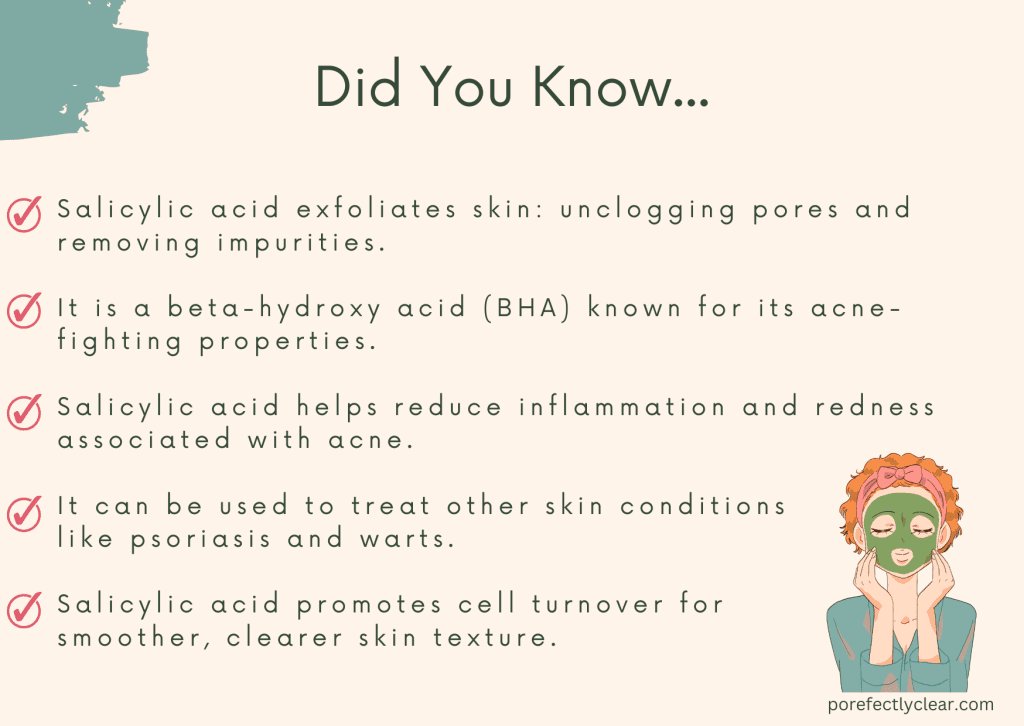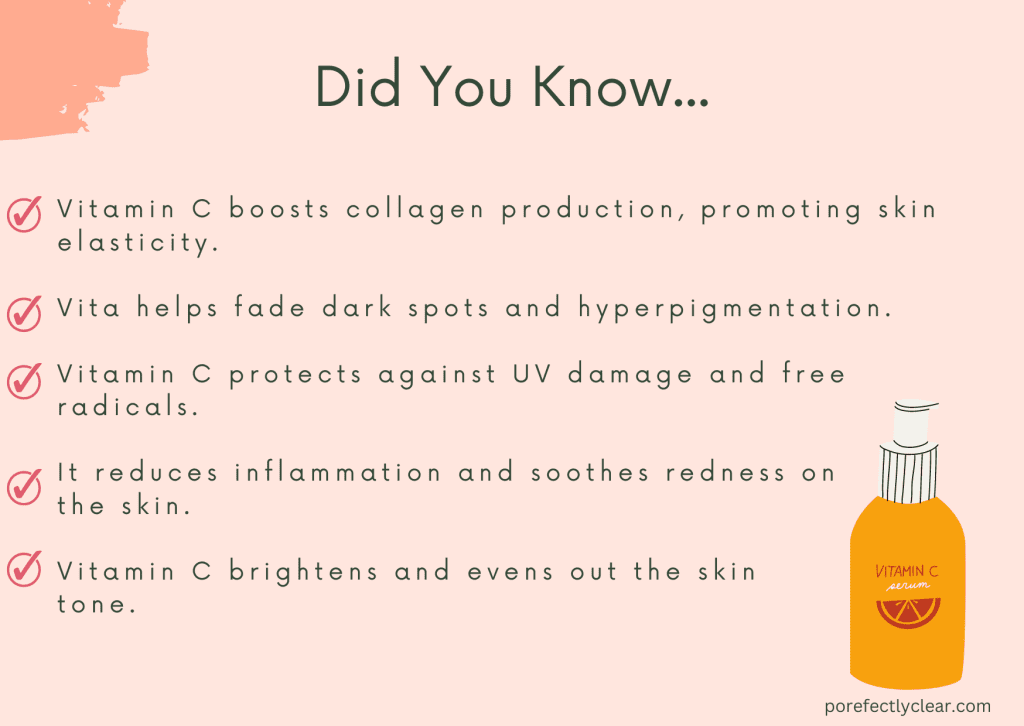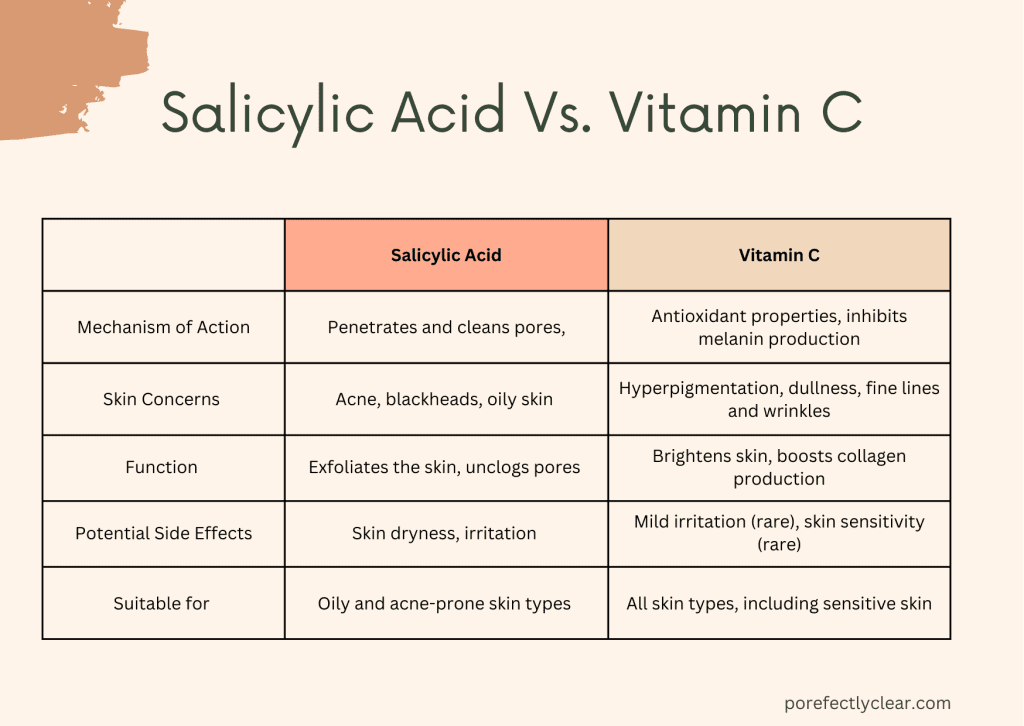Salicylic acid and vitamin C are both active ingredients commonly used in skincare. Although they serve different purposes, many are often curious if you can use salicylic acid with vitamin C.
Salicylic acid exfoliates and penetrates deeper into the pores, while vitamin C brightens the skin’s surface. If you have sensitive skin, start by using both ingredients separately before combining them. Introduce salicylic acid every other day and vitamin C in the morning before applying SPF.
What is Salicylic Acid?
Salicylic acid is a chemical exfoliant that is widely used in skincare products for its various benefits. It is known for its ability to unclog pores, reduce inflammation, and brighten skin tone.
- Reduces Acne: Salicylic acid has the power to penetrate deep into the pores and dissolve excess oil and dead skin cells. This reduces the chances of acne, unclogs pores, and minimizes their appearance.
- Exfoliates Dead Skin Cells: Salicylic acid accelerates cell turnover, which helps remove dead skin cells from the surface of your skin. By doing so, it reveals fresher, brighter-looking skin.
- Treats Hyperpigmentation: Salicylic acid can also help with hyperpigmentation by fading dark marks caused by acne or sun damage. It works by gradually exfoliating the top layer of skin to reveal lighter and brighter areas underneath.
- Reduces Fine Lines & Wrinkles: Aside from being great for acne-prone skin, salicylic acid’s anti-aging properties are often overlooked. Typically used in lower concentrations than glycolic or lactic acids, it helps smooth out fine lines due to its ability to penetrate deeper into the pores.

It’s essential always to follow instructions when using skincare products containing salicylic acid as it may cause drying or irritation.
What is Vitamin C?
Vitamin C plays a significant role in skincare due to its various beneficial properties. It is a powerful antioxidant that can help protect the skin from damage caused by free radicals. Here are some key ways in which Vitamin C benefits the skin:
- Collagen synthesis: Vitamin C is essential for the production of collagen, a protein that helps maintain the skin’s elasticity and firmness. Collagen production naturally declines with age, leading to wrinkles and sagging skin. By applying Vitamin C topically or including it in skincare products, you can promote collagen synthesis and help improve the appearance of fine lines and wrinkles.
- Brightening and evening out skin tone: Vitamin C has skin-brightening properties and can help reduce the appearance of hyperpigmentation, dark spots, and uneven skin tone. It inhibits the production of melanin, the pigment responsible for dark spots, and can promote a more radiant and even complexion over time.
- Protection against UV damage: While Vitamin C cannot replace sunscreen, it can offer some degree of protection against sun damage. It acts as a scavenger of free radicals generated by UV exposure and can help minimize the harmful effects of UV radiation on the skin.
- Anti-inflammatory properties: Vitamin C has anti-inflammatory properties, which can help calm and soothe the skin. It may be beneficial for individuals with sensitive or acne-prone skin as it can help reduce redness and inflammation.

Remember, it’s always a good idea to consult with a dermatologist or skincare professional for personalized advice based on your skin type, concerns, and any specific conditions you may have.
Benefits of Using Salicylic Acid and Vitamin C Together
The amalgamation of salicylic acid and vitamin C is a popular beauty trend and for all the right reasons. The potency of this combination targets several skin concerns and provides numerous benefits.
- Reduces signs of aging: Salicylic acid clears the pores by breaking down dead skin cells while vitamin C stimulates collagen production- reducing wrinkles, fine lines, and blemishes.
- Prevents breakouts: Salicylic acid has anti-inflammatory properties that reduce redness, and irritation- subsequently preventing acne. Simultaneously, vitamin C protects against free radicals that can cause breakouts.
- Brightens skin: Salicylic acid lightens hyperpigmentation and fades dark spots when used in conjunction with vitamin C. Both working together brightens the skin.
- Hydrates the Skin: Retaining moisture is crucial for healthy and youthful-looking skin. Salicylic Acid prevents water loss from the skin barrier while Vitamin C enables it to retain moisture better.
Adopting a skincare routine centered around these compounds can significantly improve the overall appearance of your skin. Remember to use sunscreen regularly as Vitamin C enhances sun damage which overnight can undo any progress made in skincare.
Potential Risks of Using Them Together
When Salicylic Acid and Vitamin C are used together, there is a possibility of adverse effects. Even though this combination could present attractive benefits, caution should be exercised while assessing the potential risks it poses.
- The combination of Salicylic Acid and Vitamin C could lead to skin irritation, resulting in rashes, redness, or peeling; the reason behind this is the acidic nature of both substances.
- Using Salicylic Acid in combination with Vitamin C might neutralize their potential as they both work differently on the skin. Thus, negating each other’s effect.
- Another risk associated with combining these acids is that they might increase photosensitivity when applied to the skin.
It is important to note that individual skin types vary, so it would be best to consult a medical professional before using two active ingredients at once.
Using Salicylic acid and vitamin C together has gained popularity among skincare enthusiasts. However, it’s essential to understand how they work together and not against each other.

Should you use vitamin C before or after salicylic acid?
Salicylic acid and vitamin C are a dynamic duo when it comes to skincare but which should you use first? Here is a step-by-step guide:
- Start with a low concentration of salicylic acid to avoid skin irritation.
- Apply salicylic acid first, as it is oil-soluble and can penetrate deeper into the skin.
- Wait for a few minutes before applying vitamin C, allowing the salicylic acid to fully absorb.
- Use sunscreen during the daytime as both ingredients can increase skin sensitivity to UV radiation.
- Avoid using them together in high concentrations as they might counteract each other’s benefits.
In addition to the above tips, it’s best practice always to patch-test new products containing these ingredients on a small area of your skin for at least 24 hours before using them on a larger area.
Related Post: Can you use vitamin C and glycolic acid together?
Conclusion
Using Salicylic Acid and Vitamin C simultaneously is possible. However, it might not be the best idea to layer them one on top of the other. Mixing these two together can lead to skin irritation and sensitivity, which can result in breakouts. Instead, apply Salicylic Acid in the morning and Vitamin C at night.
When used together, Salicylic Acid and Vitamin C can offer a variety of skin benefits such as clearing pores and reducing hyperpigmentation.
It’s important to note that salicylic acid should not be used too often as it can cause dryness or irritation. Always consult with a dermatologist if you are unsure about the appropriate use for your skin type.





